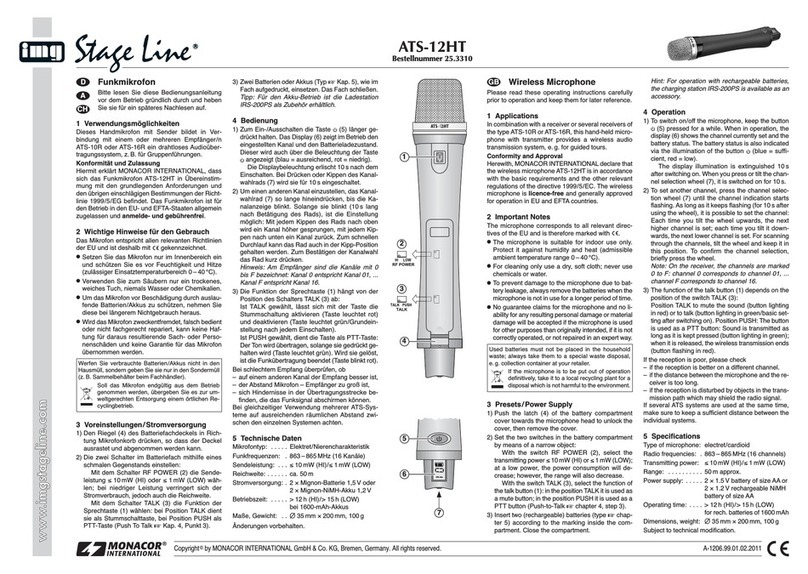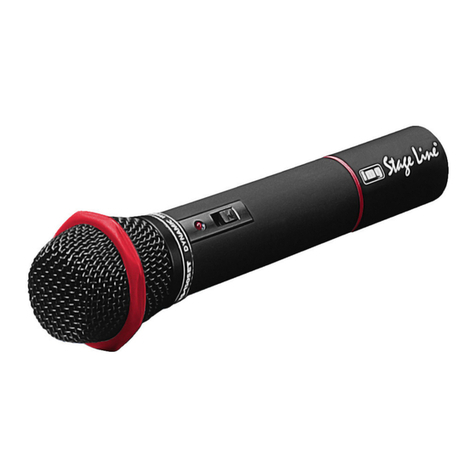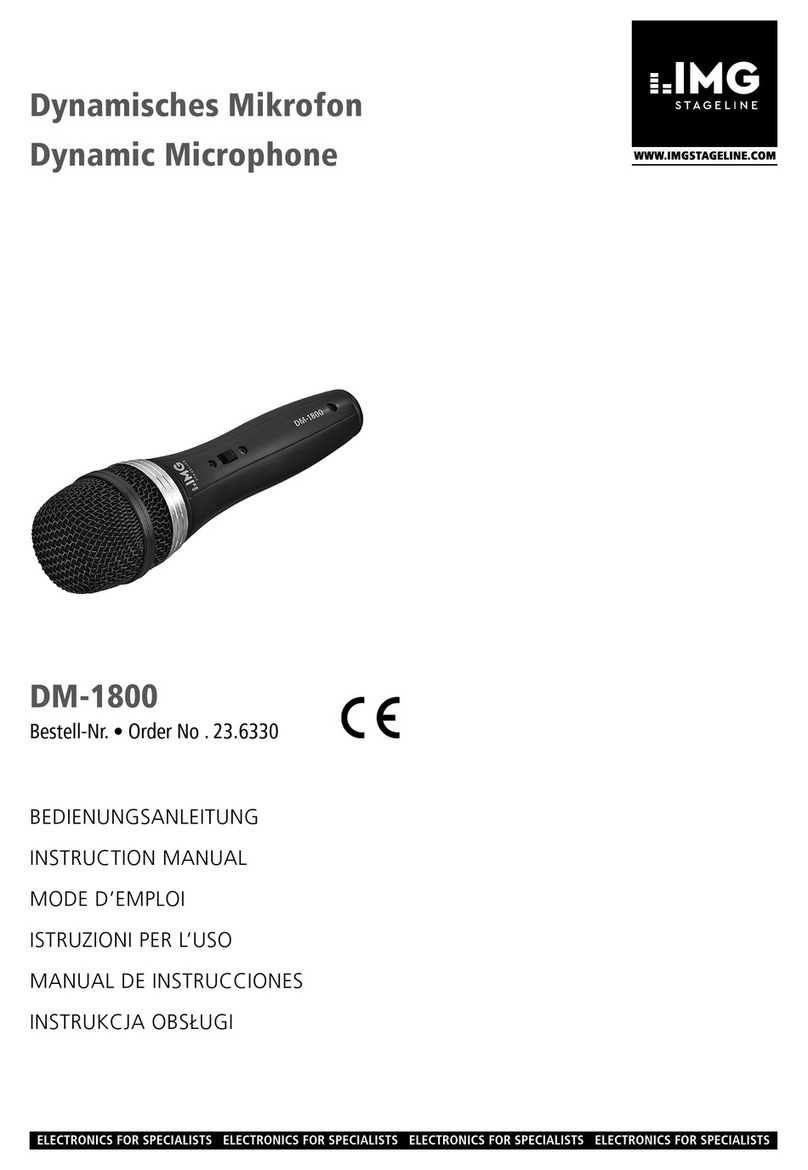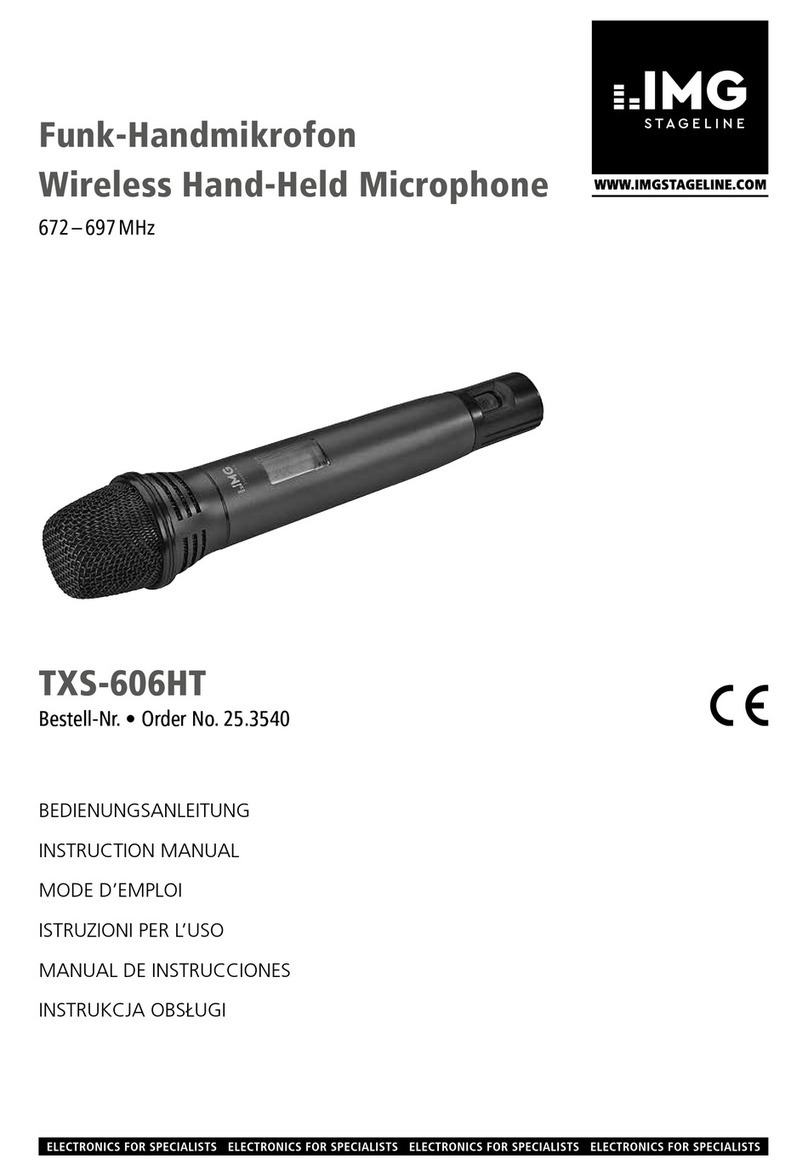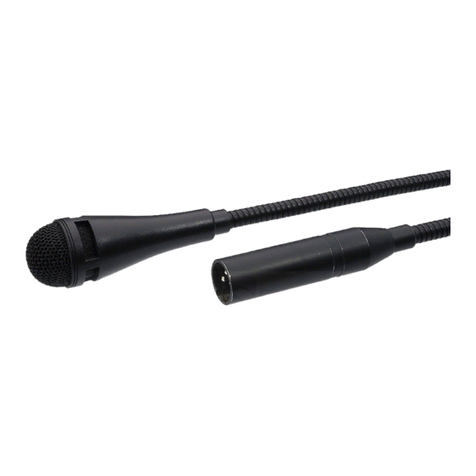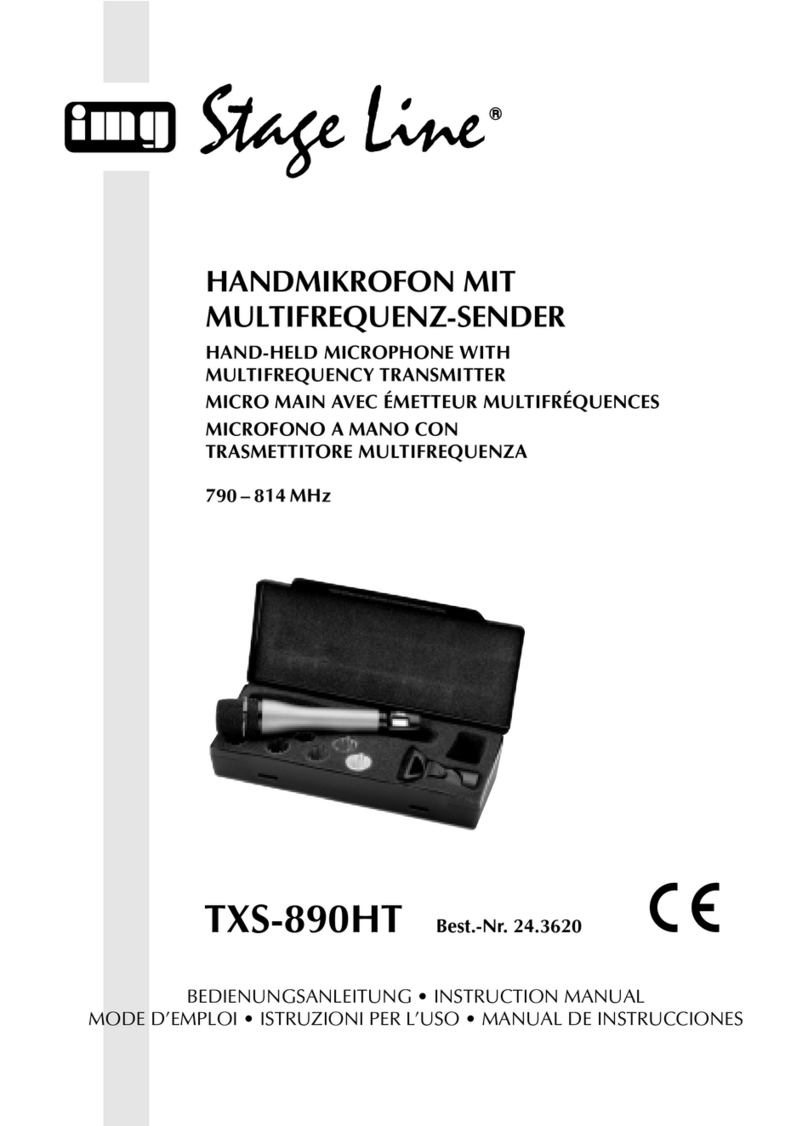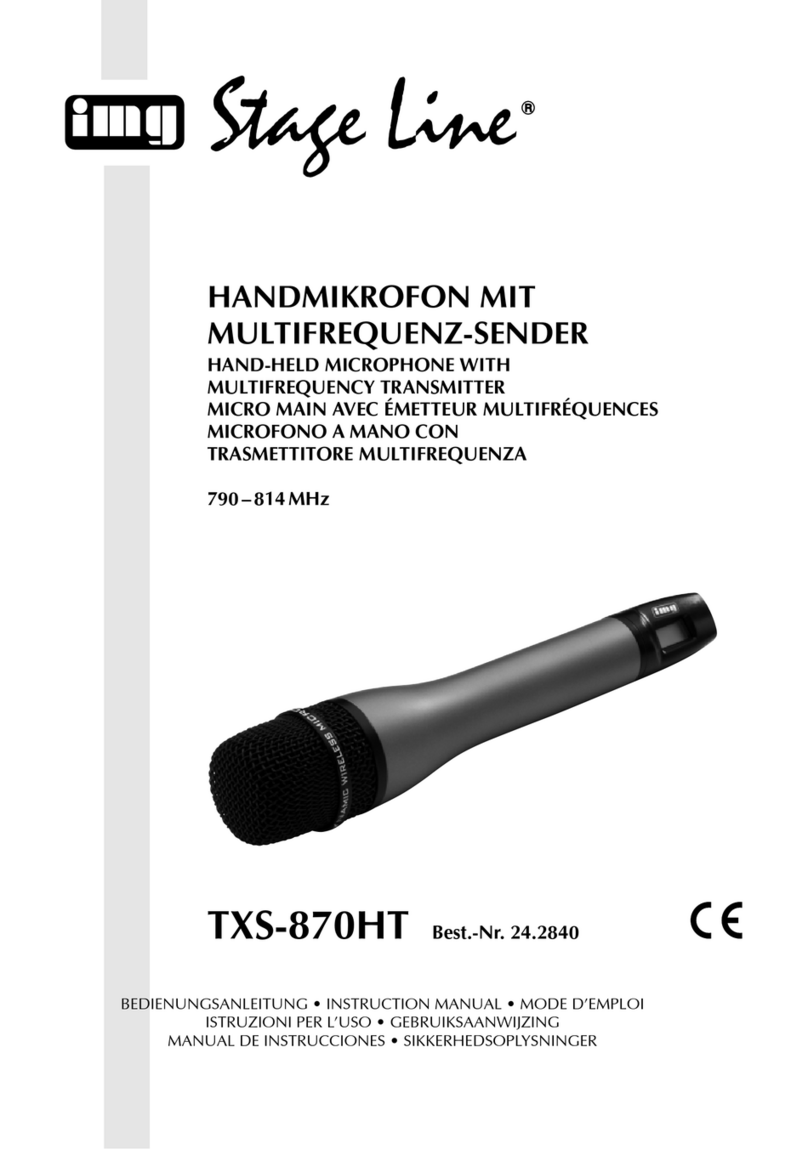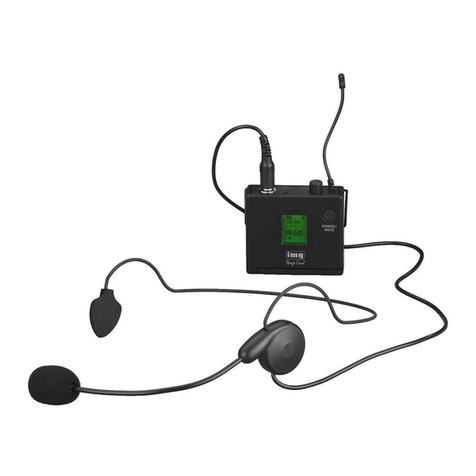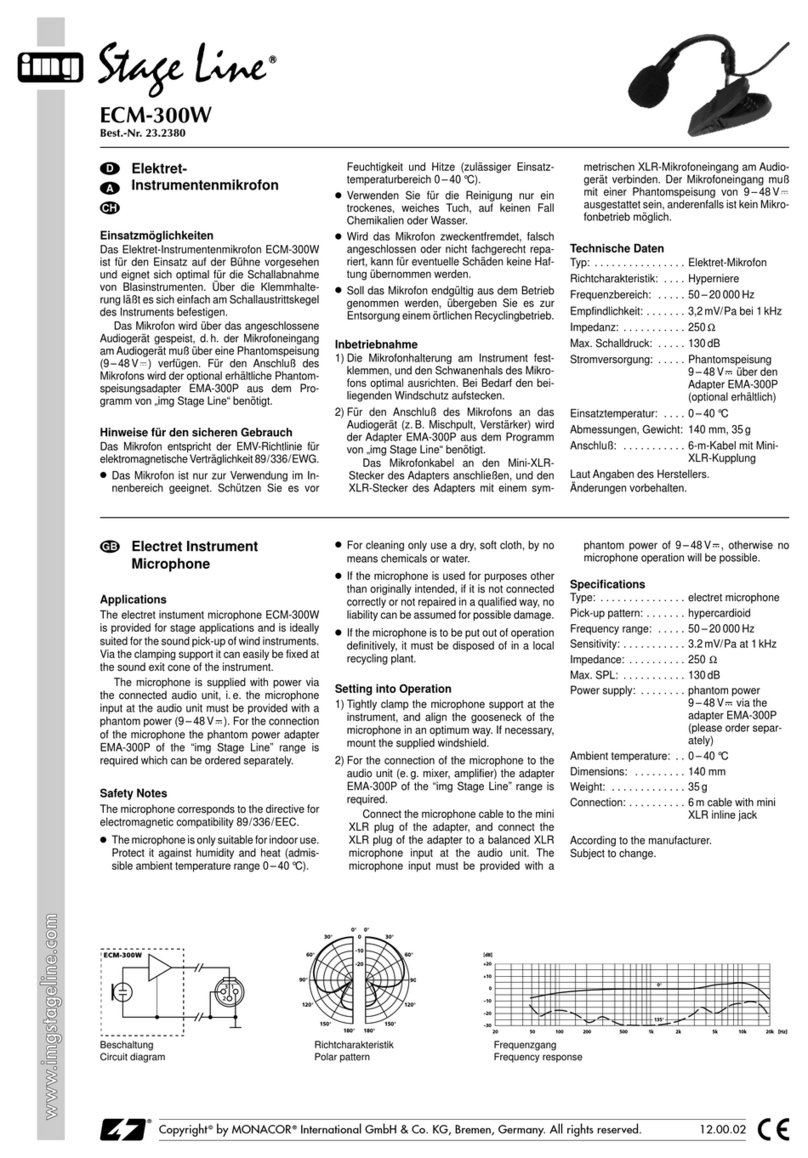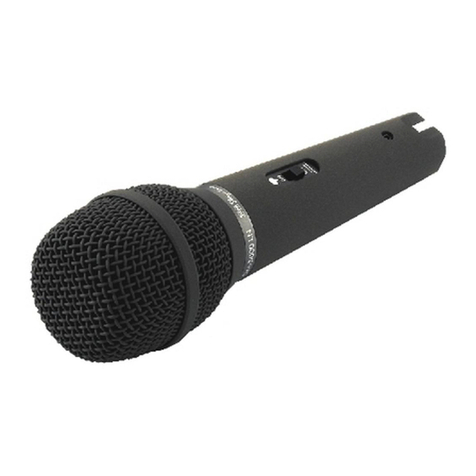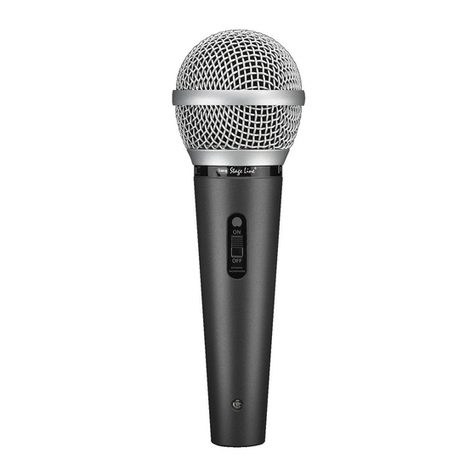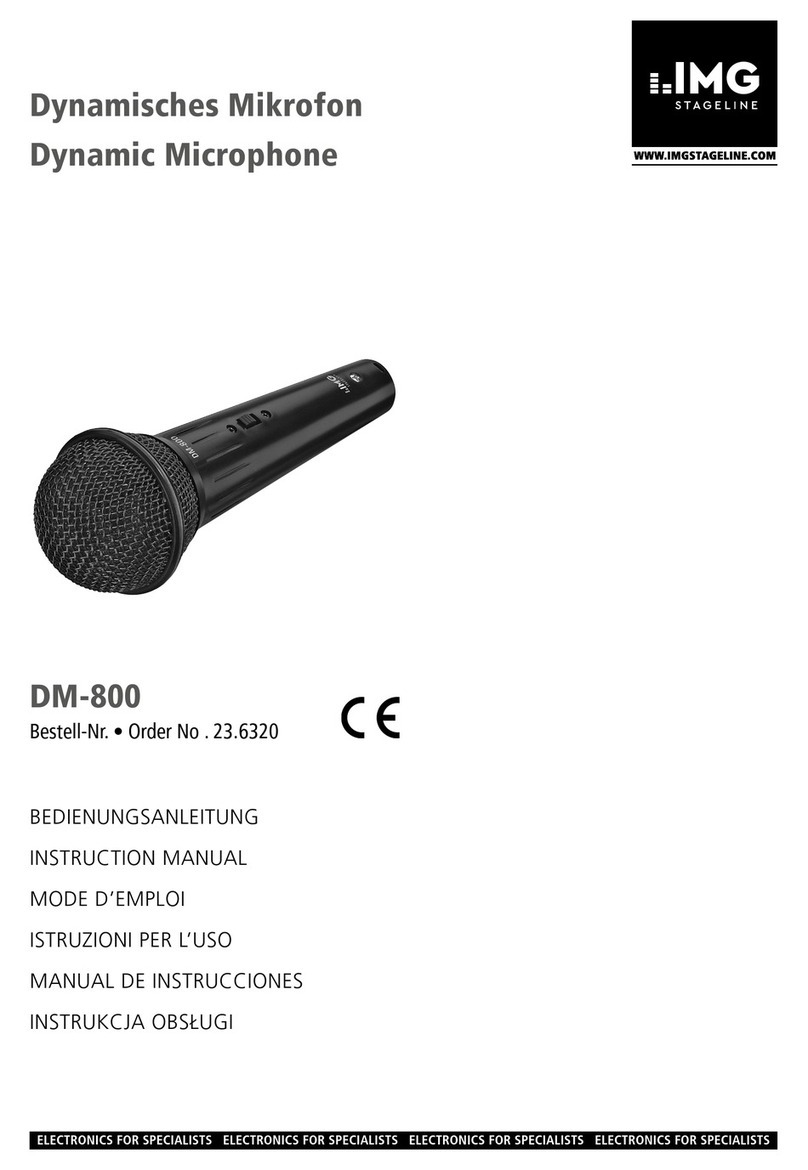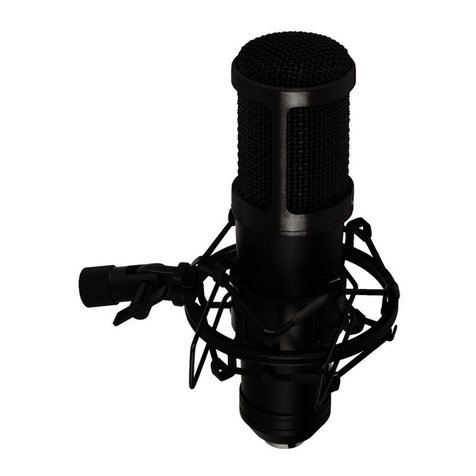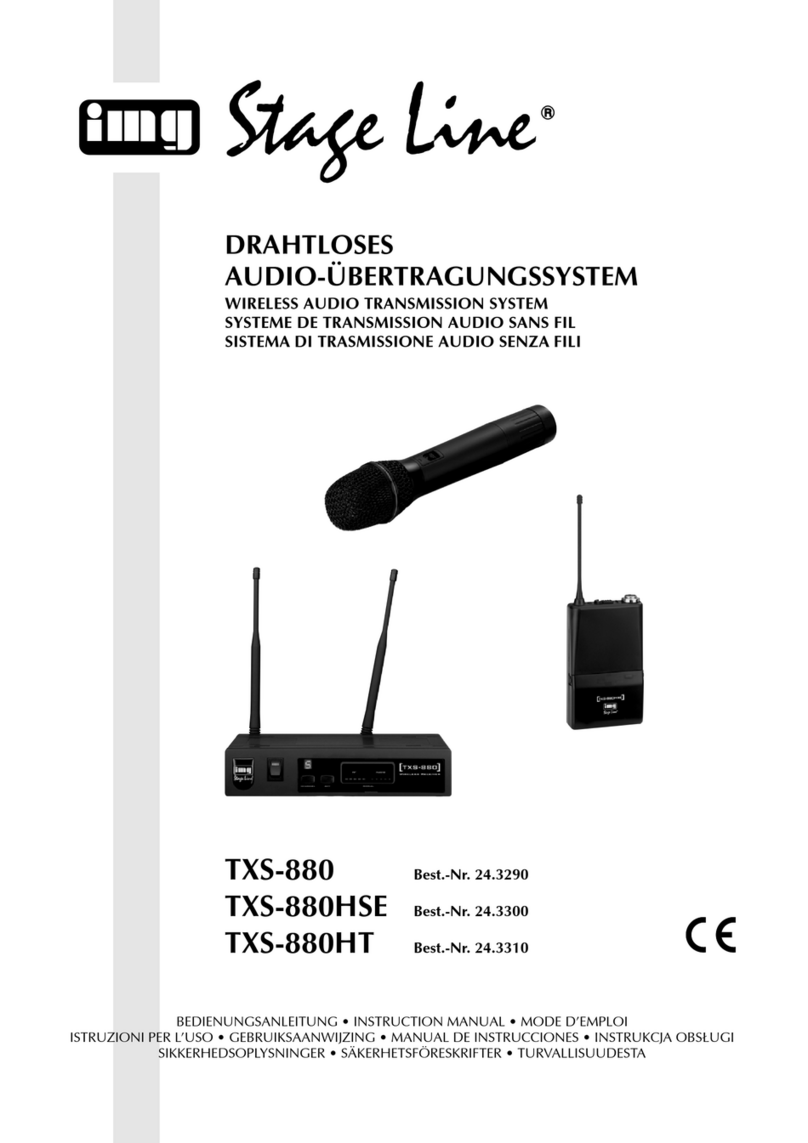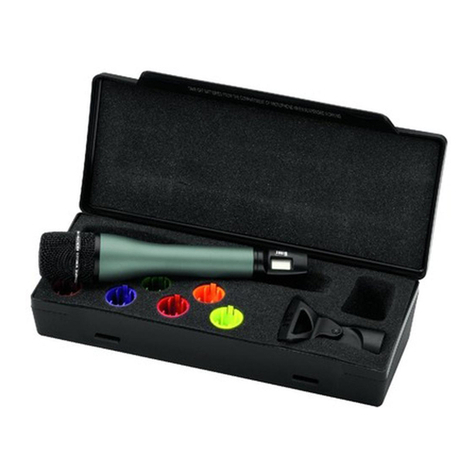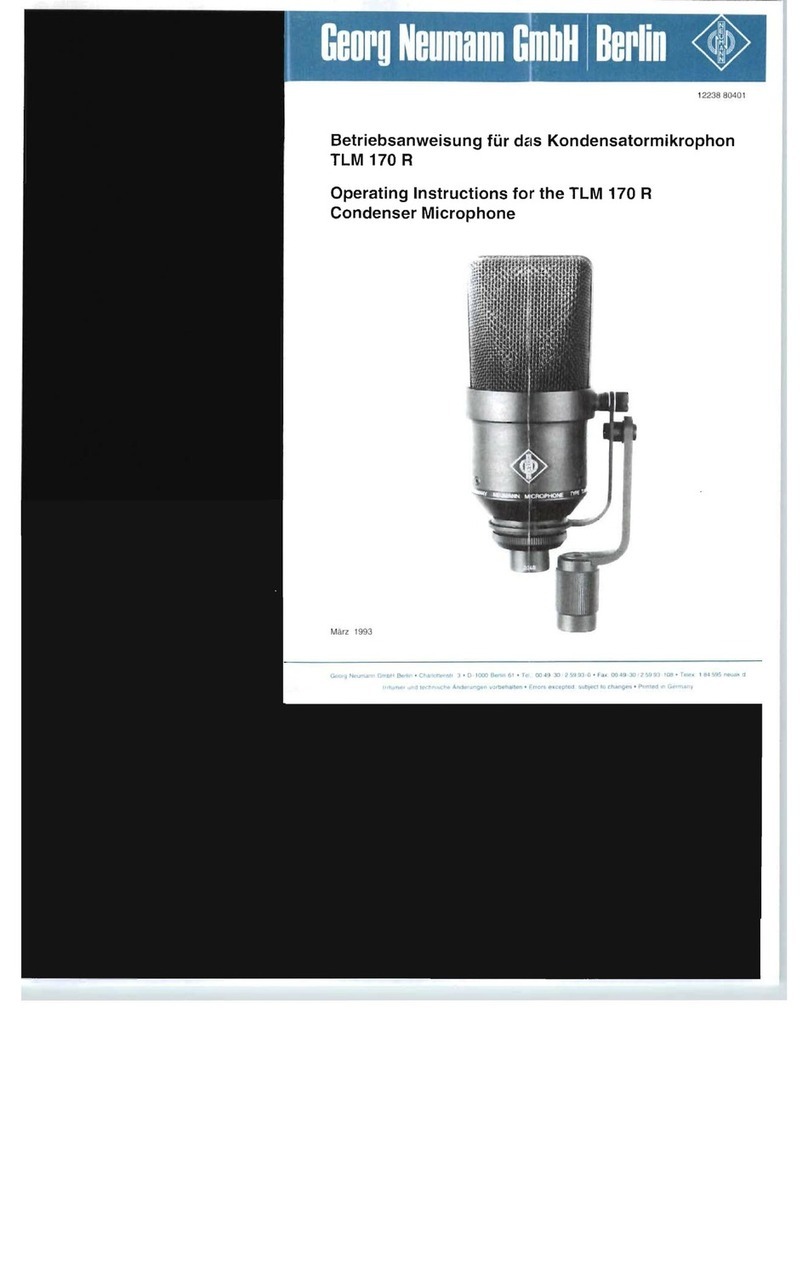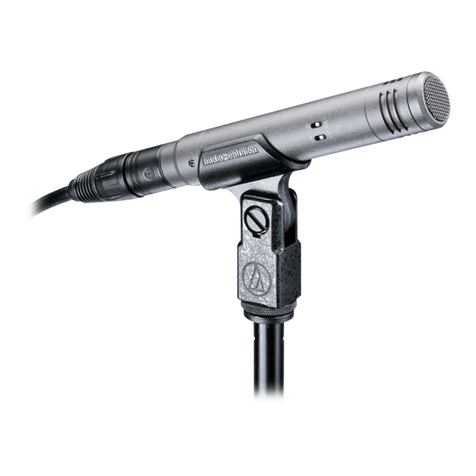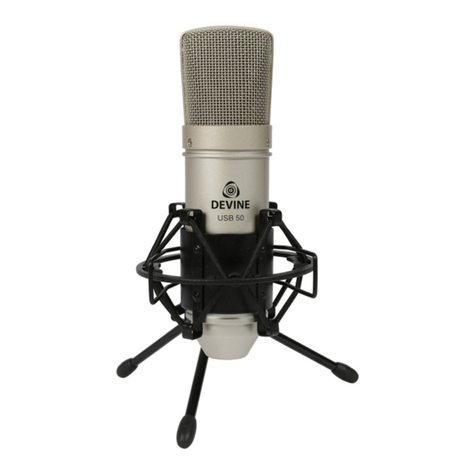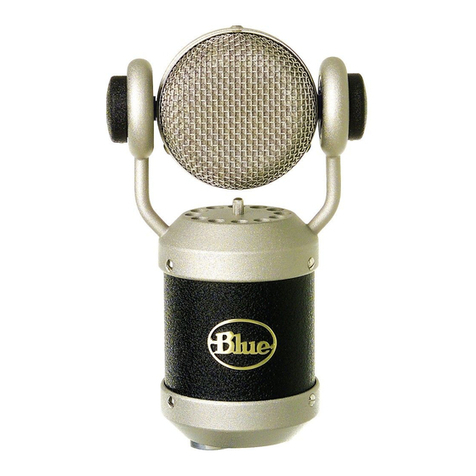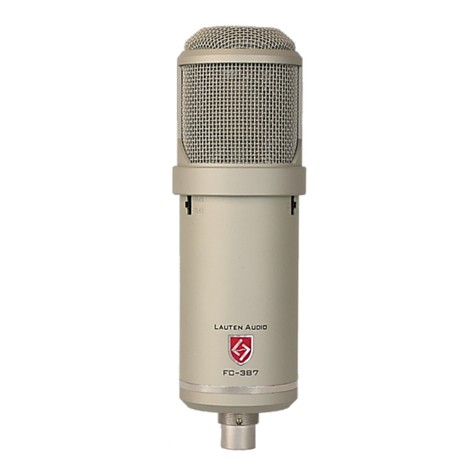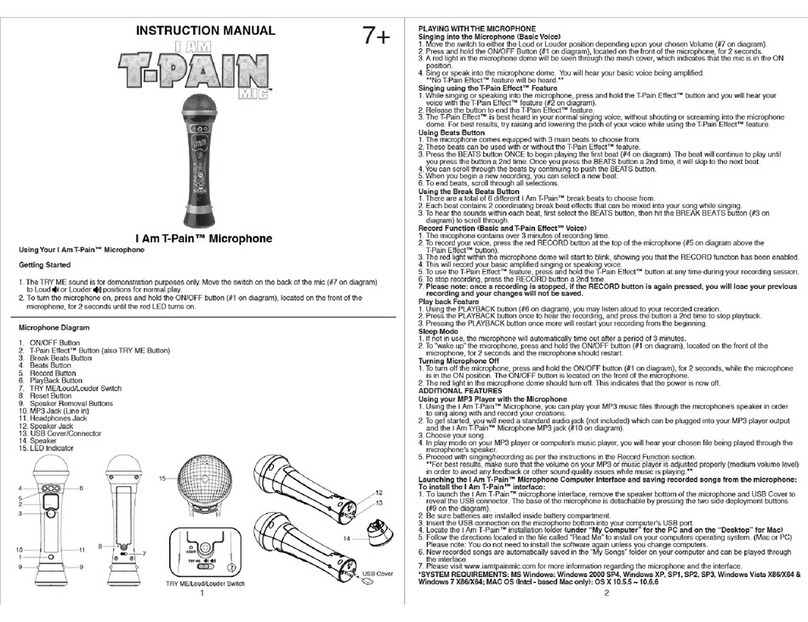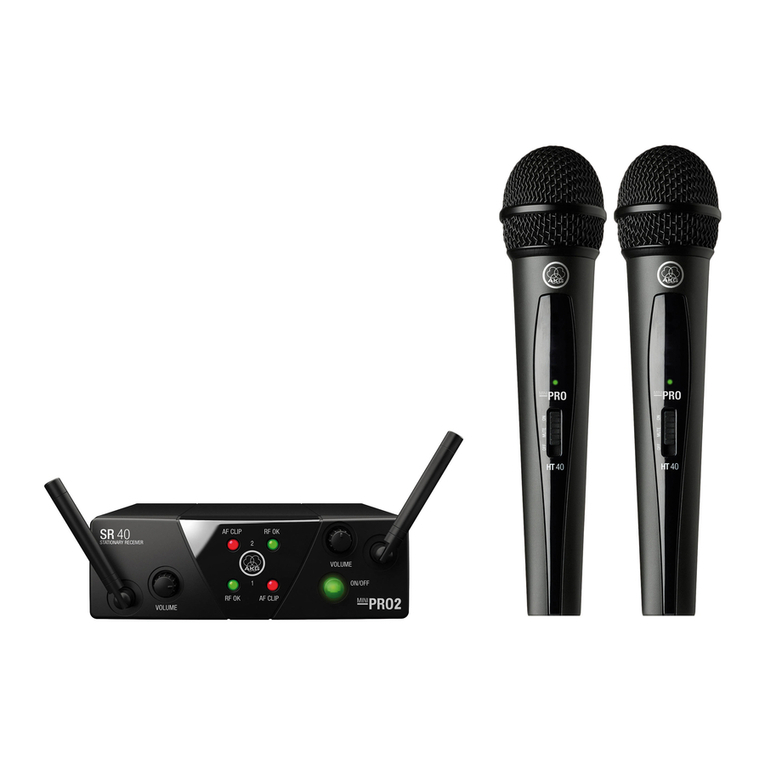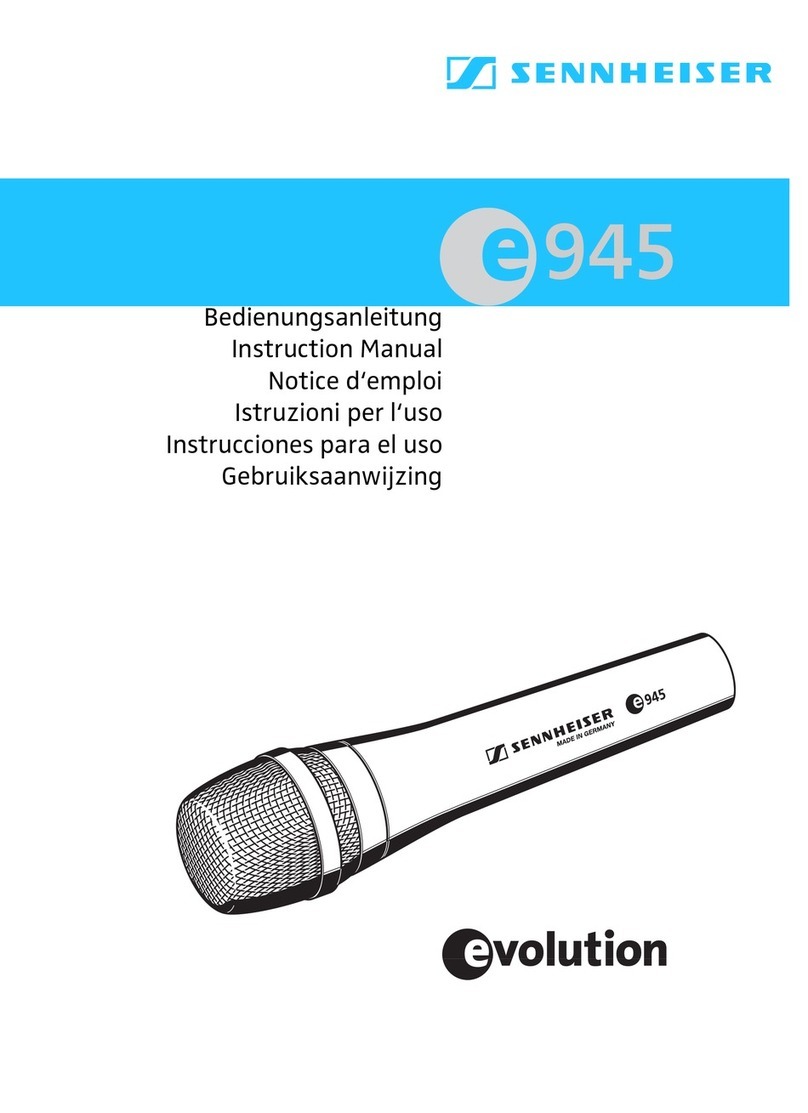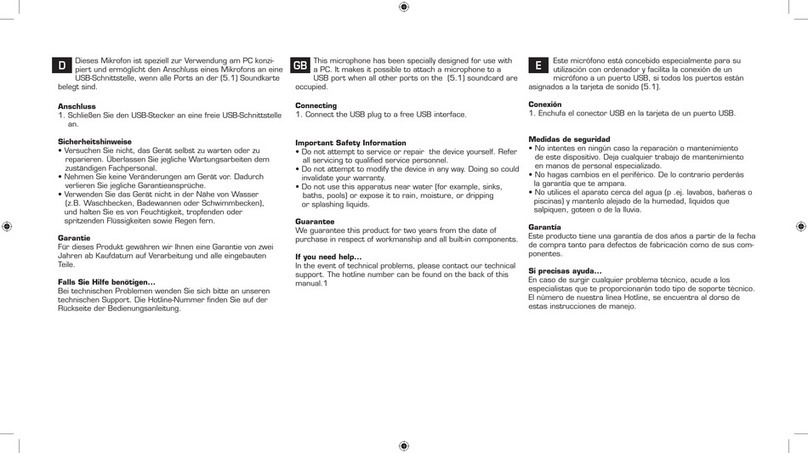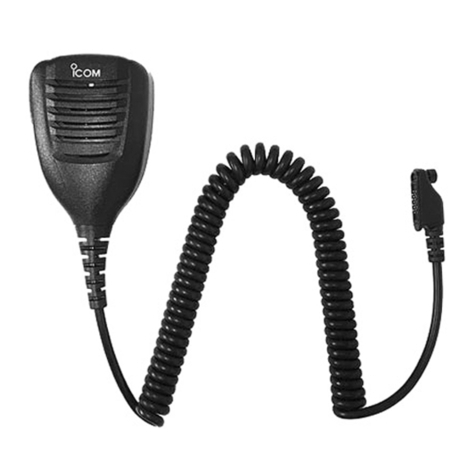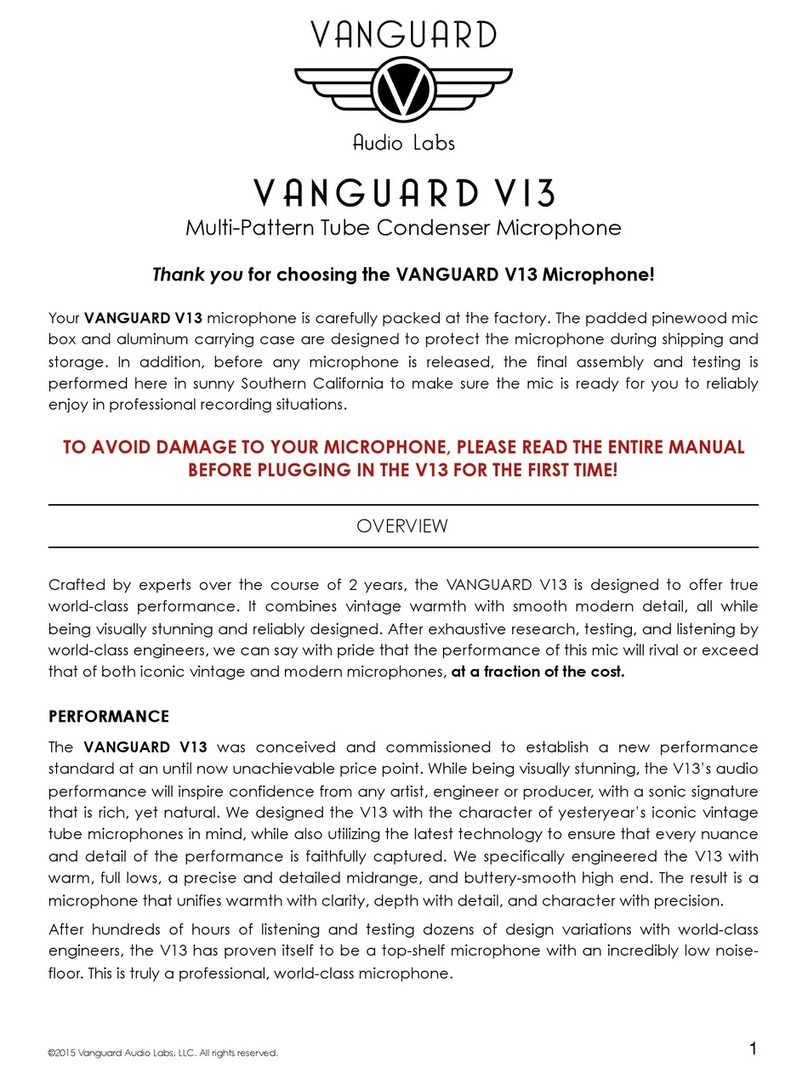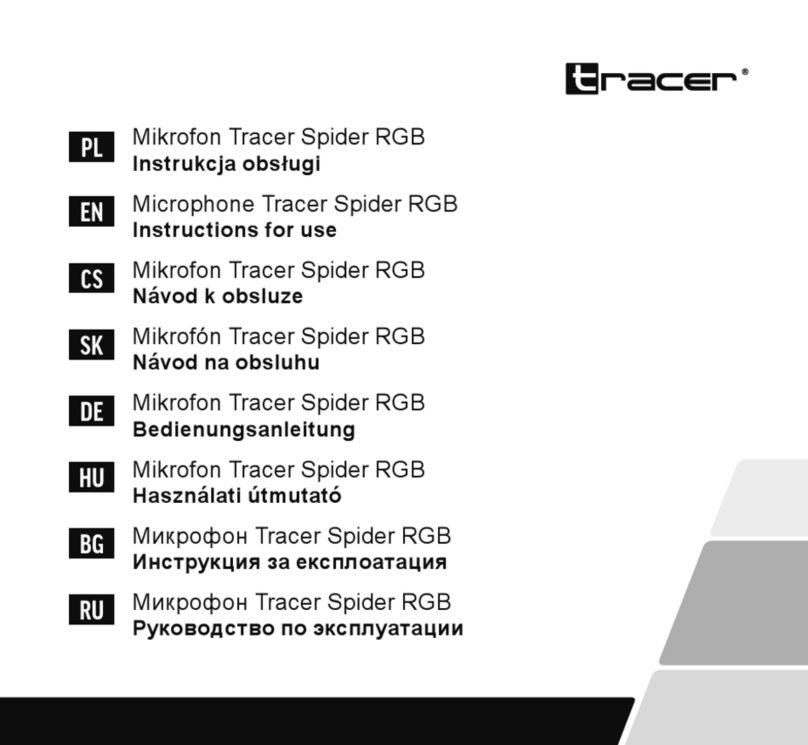Microphone électret
overhead
Possibilités d’utilisation
Le micro électret ECM-285 est conçu pour une uti-
lisation sur scène et en studio et est idéal pour la
prise de son d’instruments (p.ex. comme micro
overhead pour cymbale ou hi-hat) et pour les appli-
cations de discours et chant. Il peut, au choix, être
alimenté par une batterie 1,5V ou de manière ex-
terne via l’appareil audio relié (alimentation fantôme
9–48V ).
Le micro est livré avec un support avec filetage
16mm (5/8"), y compris une vis d’adaptation avec
filetage 9mm (3/8"), et un câble de branchement de
6m (le set micro DRUM-2SET est livré sans câble).
Conseils de sécurité
Le microphone ECM-285 répond à la norme eu-
ropéenne 89/336/CEE relative à la compatibilité
électromagnétique.
●Le microphone n’est conçu que pour une utilisa-
tion en intérieur; protégez-le de l’humidité et de
la chaleur (température d’utilisation admissible
0–40°C).
●Pour le nettoyer, utilisez un chiffon sec et doux,
en aucun cas de produits chimiques ou d’eau.
●Nous déclinons toute responsabilité si le micro
est utilisé dans un but autre que celui pour lequel
ila étéconçu, s’il n’est pas correctement branché
ou n’est pas réparé d’une manière qualifiée.
●Ne jetez pas les batteries usagées dans la pou-
belle domestique, ne rapportez-les qu’aux dé-
chets spéciaux (p.ex. collecteur à votre reven-
deur).
●Lorsque le micro est définitivement retiré du ser-
vice, vous devez le déposer dans une usine de
recyclage adaptée.
Fonctionnement
1) Si l’entrée micro à laquelle le micro doit être relié
n’est pas équipée d’une alimentation fantôme
9–48V , insérez une batterie 1,5V de type R6:
dévissez le couvercle (partie inférieure) en le
tournant dans le sens inverse des aiguilles d’une
montre et insérez la batterie dans le comparti-
ment en respectant la polarité (notée dans le
compartiment). Revissez le couvercle du boîtier.
En cas de non utilisation prolongée, (p.ex.
supérieure à une semaine), veillez à retirer la
batterie: si elle viendrait à couler, elle peut en-
dommager le micro.
2) Vissez le support micro livré sur un pied pour
micro: si le pied dispose d’un filetage 16mm
(5/8"), retirez la vis d’adaptation du support et vis-
sez directement le support. Si le pied a un fileta-
ge 9mm (3/8"), fixez le support via la vis d’adap-
tation. Placez le micro dans le support.
3) Branchez le micro à une entrée micro XLR de
l’appareil audio (p.ex. table de mixage, amplifi-
cateur).
4) Pour allumer le micro, mettez l’interrupteur sur
“ON”;enposition “OFF”, lemicro est déconnecté.
Caractéristiques techniques
Type: . . . . . . . . . . . . . . . microphone électret
Directivité: . . . . . . . . . . . unidirectionnel
Bande passante: . . . . . . 80–15000Hz
Sensibilité: . . . . . . . . . . 5mV/Pa à 1 kHz
Impédance: . . . . . . . . . . 400Ω
Pression sonore max.: . 115dB
Alimentation: . . . . . . . . . batterie 1,5 V (type R6)
ou alimentation fantôme
9–48V
Temp. d’utilisation: . . . . 0–40°C
Dimensions: . . . . . . . . . Ø 26/24mm x 195mm
Poids: . . . . . . . . . . . . . . 110g
Branchement: . . . . . . . . XLR symétrique
D’après les données du constructeur.
Tout droit de modification réservé.
Microfono overhead
all’elettrete
Possibilità d’impiego
Il microfono all’elettrete è previsto per l’impiego pro-
fessionale sul palcoscenico e nello studio di regi-
strazione ed è indicato in modo ottimale per la ri-
produzionedi strumenti musicali(p.es.come micro-
fono overhead per piatti, hi-hat) nonché per il canto
e la lingua parlata.Ascelta, il microfono può essere
alimentato da una batteria 1,5V oppure dall’appa-
recchio audio collegato (alimentazione phantom
9–48V ).
Haindotazioneunsupportoconfilettatura16mm
(5/8") equipaggiato con un adattatore con filettatura
9mm (3/8") nonché. In dotazione c’è anche un cavo
di collegamento di 6m (il set DRUM-2SET è senza
cavo).
Avvertenze di sicurezza
Questo microfono corrisponde alla direttiva CE
89/336/CEE sulla compatibilità elettromagnetica.
●Lo strumento è previsto solo per l’uso all’interno
di locali. Proteggerlo dall’umidità e dal calore
(temperatura d’impiego ammessa fra 0°C e
40°C).
●Per la pulizia usare solo un panno morbido,
asciutto; non impiegare in nessun caso prodotti
chimici o acqua.
●Nel caso d’uso improprio, di collegamenti sba-
gliati o di riparazione scorretta non si assume
nessuna responsabilità per eventuali danni.
●Non gettare le pile scariche nelle immondizie
bensì negli appositi contenitori (p.es. presso il
vostro rivenditore).
●Se si desidera eliminare il microfono definitiva-
mente,consegnarlo per losmaltimento adun’isti-
tuzione locale per il riciclaggio.
Messa in funzione
1) Se l’ingresso microfono dell’apparecchio audio
non è equipaggiato con un’alimentazione phan-
tom9–48V , montare unabatteria1,5V del tipo
mignon (AA): svitare la parte bassa del microfono
in senso antiorario ed inserire la batteria, rispet-
tando la corretta polarità (vedi sovrastampa nel
vano batteria). Riavvitare la parte svitata.
Se il microfono non viene utilizzato per un
tempo prolungato (p.es. più di una settimana)
conviene togliere la batteria per evitare danni se
la batteria perde.
2) Avvitare il supporto del microfono sul treppiede.
Se il treppiede è con filettatura 16mm (5/8"), svi-
tare l’adattatore dal supporto ed avvitare il sup-
porto direttamente sul treppiede. Se il treppiede
è con filettatura 9mm (3/8") usare l’adattatore per
il fissaggio. Inserire il microfono nel supporto.
3) Collegare il microfono con un ingresso microfono
XLR dell’apparecchio audio (p.es. mixer, amplifi-
catore).
4) Per accendere il microfono spostare l’interruttore
da “OFF” (spento) su “ON”.
Dati tecnici
Tipo: . . . . . . . . . . . . . . . microfono all’elettrete
Caratteristica: . . . . . . . . a cardioide
Banda passante: . . . . . . 80–15000Hz
Sensibilità: . . . . . . . . . . 5mV/Pa a 1kHz
Impedenza: . . . . . . . . . . 400Ω
Pressione sonora max.: 115dB
Alimentazione: . . . . . . . batteria 1,5V mignon
(AA) oppure alimenta-
zione phantom 9–48V
Temperatura d’impiego: 0–40°C
Dimensioni: . . . . . . . . . . Ø 26/24mm x 195mm
Peso: . . . . . . . . . . . . . . . 110g
Collegamento: . . . . . . . . XLR, simmetrico
Dati forniti dal produttore.
Con riserva di modifiche tecniche.
I
Copyright©by MONACOR®International GmbH & Co. KG, Bremen, Germany. All rights reserved. 12.00.01
®
ECM-285
Best.-Nr. 23.2760
wwwwww..iimmggssttaaggeelliinnee..ccoomm
Courbe de réponse
Risposta di frequenza
Caractéristique de directivité
Caratteristica direzionale



